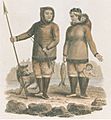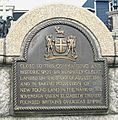Newfoundland facts for kids
Newfoundland is an island off the East Coast of Canada, and is part of the Canadian province of Newfoundland and Labrador. The capital city of Newfoundland is St. John's, on the north-east part of the island. Over 500,000 people live in Newfoundland (these people are called Newfoundlanders). It, along with Labrador on the mainland, became part of Canada on March 31, 1949. There is no bridge or tunnel from Newfoundland to the rest of the country but there is a ferry to Nova Scotia.
In Newfoundland, most people speak English, but there are also French speakers on the island, mostly in the south-west. In some areas of Newfoundland, people speak with an accent and use words that are not in standard English. There is even a dictionary of Newfoundland English.
People first came to Newfoundland from countries like Norway, England, Portugal, France, and Ireland in the 16th century. The first explorers were the Vikings from Norway and they settled in L'Anse aux Meadows. They came because of the good fishing off the coast, especially off the south-east coast. Eventually they left because of disagreements with aboriginals.Today, there is still fishing, but not very much because people fished too much, and now there are not many fish left.
Cutting down trees and mining have also been attractions of the island. There are some paper mills (paper factories) in a few cities in Newfoundland.
Images for kids
-
The Long Range Mountains on Newfoundland's west coast are the northernmost extension of the Appalachian Mountains.
-
An artistic depiction of the Maritime Archaic culture, at the Port au Choix Archaeological Site. The Maritime Archaic peoples were the first to settle Newfoundland.
-
Depiction of the Inuit of Labrador, c. 1812
-
A Beothuk encampment in Newfoundland, c. 18th century
-
A statue of John Cabot at Cape Bonavista. The cape is officially cited as the area where Cabot landed in 1497, by the governments of Canada, and the United Kingdom.
-
Plaque in St. John's commemorating the English claim over Newfoundland, and the beginning of the British overseas empire
-
French forces sacking English settlements in Newfoundland in 1696
-
A French invasion of the Newfoundland was repulsed during the Battle of Signal Hill in 1762.
-
Joey Smallwood signing a document bringing Newfoundland into the Canadian Confederation, 1948
-
The Hebron oil platform, before being towed out to the Grand Banks
-
The Rooms is a provincial cultural facility that houses the provincial art gallery.
-
E. J. Pratt wrote a number of poems describing maritime life and the history of Canada.
See also
 In Spanish: Terranova y Labrador para niños
In Spanish: Terranova y Labrador para niños






















